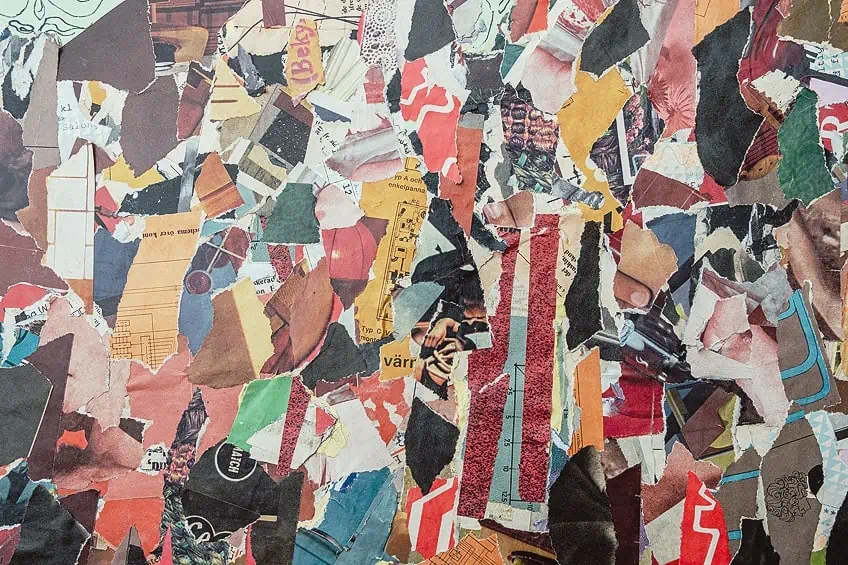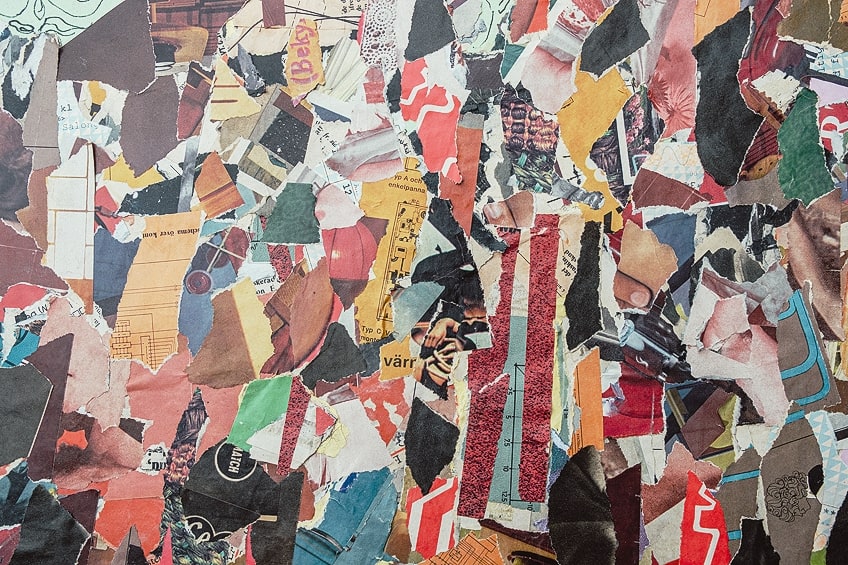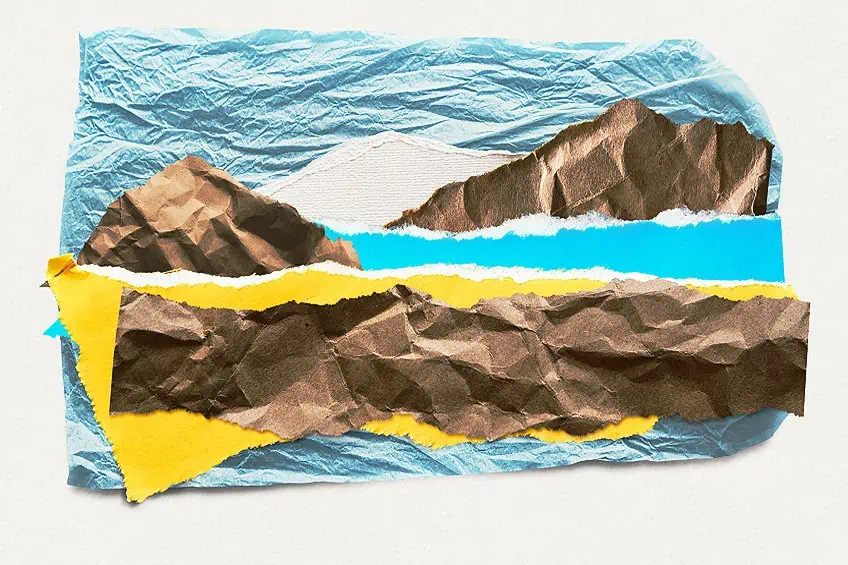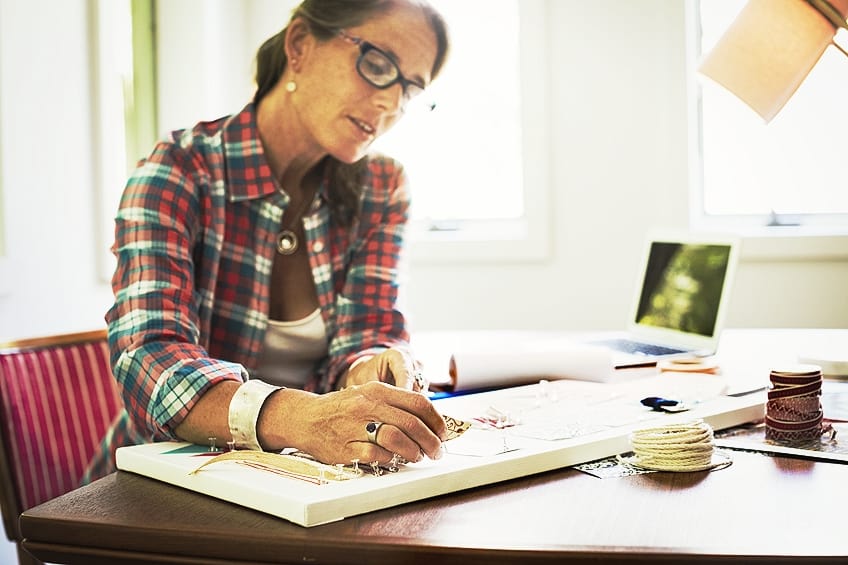Mixed Media Art – Collages of Imagination
What is mixed media art, and what are some examples of mixed media artworks by famous artists? In the material sense, art can manifest itself in many ways that require us to think creatively about the mediums we use and the messages that we want to convey. In this article, we will dive into all you need to know about the world of mixed media art, including a brief history of mixed media art in the 20th century, the different types of mixed media art that exist today, and a few famous mixed media art examples that you can use to inspire your next project. Keep reading to learn all about mixed media art!
Contents
All About Mixed Media Art: What Is It?
You may have heard the term “mixed media” thrown around when artists describe an artwork or when viewing the label of an interesting artwork hanging on the wall of your favorite gallery. To most people, mixed media artworks often resemble collage-like structures, however, mixed media artworks in themselves offer quite a range in terms of definitions. So, what is mixed media art?

Mixed media art refers to art that is constructed using different materials and a combination of such, which makes the artwork possess certain visual qualities that remind one of a painting, sculpture, and drawing all married in one work of art. This type of art is often confused with another type of art called multi-media art, which describes art that is produced using a range of digital or electronic media such as computers and video art. As such, to understand mixed media art, one can best look at the physicality of the artwork and break down the materials used in the work that make it “mixed media”. Three key terms to consider in mixed media art are medium, collage, and visual art, all of which come together in different arrangements and materials to form a mixed media artwork.
Unveiling the History of Mixed Media in Art
When did the term “mixed media art” first enter the art world? The first identifiable piece of mixed media art from the 20th century was said to be a collage made by Spanish Modern artist Pablo Picasso in 1912. The artwork titled Still Life with Chair Caning has been pinpointed as a mixed media artwork since it was composed of paint, paper, rope, and fabric to produce a level of three-dimensionality on the flat artwork. It is said that modern movements and ideas circulating among styles belonging to the Dadaism and Cubism movements were responsible for the emergence of mixed media art as a modern genre that would soon gain traction among the circles of artists like Ellsworth Kelly and Henri Matisse.
As such, the progression of mixed media art in the 20th century was seen from collages, all the way to sculptural configurations known as assemblages and installations.
Exploring the Different Types of Mixed Media Artwork
Mixed media art can be created in many different ways and appear in numerous forms. This means that artists have a greater level of visual freedom when it comes to creating mixed media art since the conventions for the genre are almost non-existent and lie undefined. Below is a summary of the different types of mixed media artworks, which will expand your knowledge of what a mixed media artwork can look like.
Collage Artworks
Collage art is a type of mixed media art form that dates back hundreds of years yet has emerged most prominently as an official art form in the 20th century. In collages, one can best imagine the works of famous Cubists to provide a visual reference in terms of what collages may look like. Collage artworks are created using a solid base such as canvas or wood and can be built upon using other materials or mediums such as paint, paper, and fabric.
When arranged haphazardly, one can gain the impression that the work appears “unplanned”, yet somehow, still makes sense, visually. In collage art, one can experiment with different textures and combinations to create unique and eye-catching compositions. Collages, as such, do not need to be messy and can be composed strategically. Artists can consider adding other media such as photography and ink to make the piece more interesting.
Combining Wet and Dry Materials in Painting
While this approach is not a defined genre under mixed media art, it is one way that you can quickly identify a mixed media piece of art. By combining wet and dry media, for example, a sketch and paint, artists can produce multiple effects that make the texture of each medium truly shine. One of the most creative ways artists can practice the combination of wet and dry media in mixed media painting is by using charcoal sticks on a primed canvas with oil-based paint to simply explore how the two different types of media can complement each other.
A popular mixed media technique known as resist can help you produce a fresh aesthetic in your mixed media paintings since it fuses water and oil-based paints.
Découpage
This type of art practice involves gluing paper cutouts or pieces of textile onto other objects and then applying a layer of adhesive or varnish over the object to make it appear painted. This technique is called découpage and is usually employed as a craft for elevating home goods and upcycling old objects. This can be applied on many surfaces, from lamp shades to furniture and when applied in fine art, can be used to creatively transform the notion of the everyday or found object in your mixed media artworks.
Books and Notebooks As Mixed Media Art
One can also look to more creative avenues in mediums and bases that offer room to explore texture and variety. Books and notebooks can become mixed media artworks when they are altered using techniques such as collage, painting, and tearing of pages in a book to produce a new form and visual presentation of a book.
Book sculptures with miniature paintings are one such example of mixed media art, which can reflect the alteration of the book and its new function, as a work of art.
Sculptures
The term “sculpture” may immediately be associated with a three-dimensional form or object crafted from a solid medium. However, as a type of mixed media art, sculpture can also become “mixed media” when the artist chooses to infuse multiple materials, from wood and marble to found objects and wire pieces. In most cases, the artist constructs a base using a solid material and adds on and adjusts the rest of the structure of the sculpture using other materials like paint, textiles, and new shapes.

Assemblage Art
This type of mixed media art is closely associated with sculpture and painting yet is a unique genre that narrates a story using its form and materiality. Assemblage art fuses the elements of collage and sculpture to produce unique artworks that can range from the use of natural and man-made objects. Artists may combine everyday objects with traditional fine art media, including modern materials like plastic and beads to create forms that capture the imagination.
Some assemblages can remain fixed on a flat surface, hung on a gallery wall, or strung from the ceiling, depending on the structure it takes, however, the combination of materials is what makes the assemblage “mixed media”.
Famous Mixed Media Art Examples
Now that you have an idea of what mixed media art can encompass, you can browse through our selection of famous mixed media art examples that shed light on how artists have applied various techniques to create mixed media art.
Still Life with Chair Caning (1912) by Pablo Picasso
| Artist Name | Pablo Picasso (1881 – 1973) |
| Date | 1912 |
| Medium | Oil and printed oilcloth on canvas edged with rope |
| Dimensions (cm) | 29 x 37 |
| Where It Is Housed | Musée National Picasso, Paris, France |
Still, Life with Chair Caning is the most famous mixed media art example from the 20th century that was created by none other than Pablo Picasso. An experimentalist with reality, geometry, and Cubist visual principles, the Spanish artist created this mixed media artwork using a printed oil cloth and rope on an oval-shaped canvas.
Picasso selected a widely recognizable printed fabric to introduce an aspect of fiction in painting since the mass-produced print resembled the rattan weave pattern found on chairs and was only real in the material sense. The famous mixed media artwork was exhibited on loan to many prestigious Western and European art institutions, including the Museum of Modern Art and the Metropolitan Museum of Art.
Angel of Anarchy (1936 – 1937) by Eileen Agar
| Artist Name | Eileen Forrester Agar (1899 – 1991) |
| Date | 1936 – 1937 |
| Medium | Plaster, shells, fabric, beads, diamante stones, and other materials |
| Dimensions (cm) | 57 x 46 x 31.7 |
| Where It Is Housed | Tate Gallery, London, United Kingdom |
Angel of Anarchy is a famous mixed-media sculpture that was created by the Argentine-British Surrealist Eileen Agar between 1936 and 1937. The mixed media artwork was created using a combination of sea shells, beads, silk, and diamante stones, which adorn the head and make up its facial features. The textures of the materials in the work help viewers “read” the artwork as seen in the feathers, which can be viewed as the hair. The silk on the face plays a double function, existing as the skin and a blindfold, which alludes to a sense of submission, seduction, and anarchy, as suggested in the work’s title.
Agar was known to embark on trips to the British Museum to view the ethnographic collections of African artworks, which inspired her to adopt plaster as her own medium instead of bronze.
Her mixed media artworks were reflections on the African-inspired artworks that were housed at the museum and drove her to use her sculptures as preparatory sketches by applying materials directly on the plaster. For this sculpture, she used her future husband’s head, Joseph Bard, to create the clay bust for the cast. For Agar, her work tackles the struggles with gender identity, intended to inspire women to rethink their blindness in patriarchal environments in the arts. Perhaps, one might also question the blind spots of the artwork that the artist did not directly address when fighting one battle, referring to the appropriation of African mask visual languages without the acknowledgment of the struggles that occurred for British audiences and cultural workers to have access to African art.
Icarus (Icare) from Jazz (1947) by Henri Matisse
| Artist Name | Henri Émile Benoît Matisse (1869 – 1954) |
| Date | 1947 |
| Medium | One from a portfolio of twenty pochoirs |
| Dimensions (cm) | 41 x 27.8 |
| Where It Is Housed | The Museum of Modern Art, New York City, United States |
Icarus is a famous mixed media artwork by Henri Matisse that was created as preparatory works for printing illustrations in the artist’s book Jazz, which reflected his popular cut-out compositions. The original mixed media artwork was created using cut-outs from sheets of paper that were painted in gouache and then arranged in different geometric shapes. This lively and vibrant composition was inspired by the mythological figure of Icarus, who was part of a series of cut-out works that showcased his fall among the starry royal blue sky.
The mixed media artwork was then employed in a stencil technique called pochoir to transform it into a print. Such significant works by Matisse went on to influence later modernists such as Ellsworth Kelly through the artist’s use of pure color. The use of color in the artwork is also connected closely with the story of Icarus and his acceptance of inevitable death. The total number of cut-out mixed media collages created for the book was 20 different compositions that serve as a kind of meditational presentation.
Paete (2000) by Anselm Kiefer
| Artist Name | Anselm Kiefer (1945 – Present) |
| Date | 2000 |
| Medium | Plaster, barb wire, acrylic, a dress, and shellac |
| Dimensions (cm) | 165 x 170 |
| Where It Is Housed | Lia Rumma Gallery, Milan, Napoli, Italy |
Anselm Kiefer is among the most notable mixed media artists whose mixed media paintings have inspired many painters to think about the ways that one can elevate their practice. In Paete, the German mixed media artist explores the story of Arria Maggiore and Cecina, who lived under the Roman Empire, as described by a narrative from Pliny the Younger in the Epistles. The mixed media sculpture is made up of shellac, plaster, barbed wire, a dress, and acrylic paint, and was part of a series that Kiefer called Women of the Antiquity.
According to the story, Cecina Peto, a rebel, was taken captive by soldiers during an insurrection, which led to him being shipped to Rome for execution. Peto’s wife, Arria Maggiore, followed her husband in secret and showed up to his execution to perform a radical act of self-sacrifice. She stabbed herself with a dagger to encourage him since he was hesitant to die and coined the famous phrase in her own words “Peto, it doesn’t hurt. It will hurt me as much as you will hurt yourself”.
Bleeding Takari II (2007) by El Anatsui
| Artist Name | El Anatsui (1944 – Present) |
| Date | 2007 |
| Medium | Liquor bottle tops and copper wire |
| Dimensions (cm) | 376 x 557 x 78 |
| Where It Is Housed | The Museum of Modern Art, New York City, United States |
El Anatsui is one of the best-known contemporary mixed media artists of the current era whose unique tapestries and mixed media sculptures have become a sensation in the art world. Anatsui is a Ghanaian artist who gained global recognition for his use of bottle caps, which he acquired from alcohol recycling banks and transformed into intricate works of art that seem almost effortless.
His wall installations and hanging sculptures appear flexible despite their materiality and have piloted the artist to the forefront of the contemporary art scene.
In 2023, Anatsui was also included on the list of the most influential people in the world by TIME. Since the 1990s, Anatsui has tackled themes of postcolonial Africa and the West African diaspora concerning the use of liquor as a global trade commodity in the continent. In Bleeding Takari II, Anatsui employs red metals that appear to resemble blood that drips down the surface of the sheet. The embedded violence alludes to the notions of violence, regeneration, and decay, associated with themes of birth and renewal. The term takari is also used in his work to allude to any object, continent, person, or country to describe the condition of a collective or individual who metaphorically “bleeds”.
Useful Tips to Create Mixed Media Art
How does one go about creating a mixed media artwork? As observed from the artworks listed above, it is easy to see that combining materials appears much more challenging than previously thought since materials cannot all be fixed in similar ways. Below, we have compiled a few useful tips that will help you on your journey to exploring mixed media artwork. These include tips on mediums, adhesives, and approaches to ensure that you feel supported through the process and will hopefully encourage you to consider alternative ways of exploring the art elements.
- Do not stress too much about applying the formal methods used in traditional mediums and art-making processes. It is useful to start by thinking about the size of the artwork, the type of base, and the different materials you want to use in the artwork.
- Adopting an experimental mindset can be the best way to navigate the process since it takes the stress and weight of perfectionism off the table. Open yourself up to spontaneity and remember to have fun while you are at it.
- If you are working with a mixture of dry and wet media such as watercolor paint with charcoal or color pastels, then you can further elevate your mixed media piece by trying collage. To do this, you can lay a base with your wet media, and after drying, you can apply the dry media to establish outlines or a basic structure for your collage. To build on this “foundation”, you can then use cut-out images or texts from magazines and newspapers to insert blocks of color that complement the base.
- One can also explore the addition of embellishments and textures on a painting to produce a sculptural painting and bring the media in your art to life. Textures provided by tissue paper, ribbons, and buttons for example offer interesting visuals to contemplate on depth and dimension of a composition.
- Mixed media artworks can further be developed using digital media that can be printed on canvases and textiles to further rework and build physical mixed media artworks.
- By reviewing the works of Abstract Expressionists from the 20th century, you can also gain some inspiration for how materiality and texture play a role in the impact of an artwork. The study of mixed media artwork from this movement can also encourage you to explore the development of mixed media painting and the kinds of materials that one can use to elevate one’s painting.
- Do not be afraid to branch out into different themes and subjects for exploration. Mixed media artwork offers artists the platform to explore a wide variety of relevant and worldly topics, from gender, race, and identity to mass consumer goods, capitalism, and politics. These are among the most captivating themes to explore today and can help build key discussions around your work.
- Among the recommended materials to use in mixed media art for beginners include acid-free mixed media paper (archival), acrylic paints, stretched canvas, graphite, watercolor paper, unwanted clothing or fabric, discarded envelopes, newspapers, bristol, jar lids, a mod podge water base sealer, acrylic gel medium, PVA glue, or Lascaux acrylic adhesives.
- In addition to the materials listed above, it is always best to conduct further research when using a material with properties that you are unsure about. If working with adhesives or strong-smelling paints, make sure you are also in a well-ventilated environment.
With these famous mixed media artworks and tips in mind, you can rest assured that your journey into mixed media art has been kickstarted on the right foot. By incorporating mixed media into your practice, you will not only hone your skills in enhancing elements like texture, but you will also learn how to practically arrange materials and objects in ways that work best. We hope that you will continue to experiment with materials and mediums in visual art, and hopefully produce works that inspire others!
Frequently Asked Questions
What Is Mixed Media Art?
In fine art, mixed media artworks are defined by the use of more than one type of medium and material. These artworks can be created using the six main types of mixed media art approaches, and include the use of materials such as found objects, literature, paint, textiles, and other unconventional materials.
What Are the Different Types of Mixed Media Art?
There are many different types of mixed media artworks. These include the subgenres of sculpture, installation, painting, collage, assemblage, wet and dry media, and book art. While the top three art forms used in mixed media include collage, assemblage, and sculpture, mixed media artworks can also encompass traditional materials, which are best seen in examples of mixed media paintings.
What Is Mixed Media Painting?
The art of mixed media painting involves the integration of multiple materials and techniques to create a painting. These paintings incorporate elements like fabric, wood, and various types of papers that are layered or combined in unique ways to create a textured painting. Acrylic paint is often included in mixed media paintings alongside other materials such as found and readymade objects.
What Adhesives Are Recommended for Creating Mixed Media Art?
When working with mixed media art, it is often recommended that beginner artists start with PVA glue as an adhesive and experiment with other Mod Podge substances to finish off collages and decoupages. One can also try fabric glue when incorporating textiles and contact cement for a more permanent adhesion. It is best to research the kind of material you are using and determine its durability and how strong you would prefer the adhesive to be. Different adhesives are available for different materials, however, the most common type is PVA glue.
Jordan Anthony is a Cape Town-based film photographer, curator, and arts writer. She holds a Bachelor of Art in Fine Arts from the University of the Witwatersrand, Johannesburg, where she explored themes like healing, identity, dreams, and intuitive creation in her Contemporary art practice. Jordan has collaborated with various local art institutions, including the KZNSA Gallery in Durban, the Turbine Art Fair, and the Wits Art Museum. Her photography focuses on abstract color manipulations, portraiture, candid shots, and urban landscapes. She’s intrigued by philosophy, memory, and esotericism, drawing inspiration from Surrealism, Fluxus, and ancient civilizations, as well as childhood influences and found objects. Jordan is working for artfilemagazine since 2022 and writes blog posts about art history and photography.
Learn more about Jordan Anthony and about us.
Cite this Article
Jordan, Anthony, “Mixed Media Art – Collages of Imagination.” artfilemagazine – Your Online Art Source. January 11, 2024. URL: https://artfilemagazine.com/mixed-media-art/
Anthony, J. (2024, 11 January). Mixed Media Art – Collages of Imagination. artfilemagazine – Your Online Art Source. https://artfilemagazine.com/mixed-media-art/
Anthony, Jordan. “Mixed Media Art – Collages of Imagination.” artfilemagazine – Your Online Art Source, January 11, 2024. https://artfilemagazine.com/mixed-media-art/.






